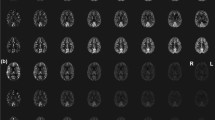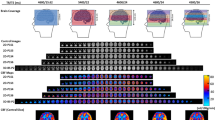Abstract
Purpose
This study aimed to evaluate the usefulness of transit time corrected cerebral blood flow (CBF) maps based on multi-phase arterial spin labeling MR perfusion imaging (ASL-MRP).
Methods
The Institutional Review Board of our hospital approved this retrospective study. Written informed consent was waived. Conventional and multi-phase ASL-MRPs and dynamic susceptibility contrast MR perfusion imaging (DSC-MRP) were acquired for 108 consecutive patients. Vascular territory-based volumes of interest were applied to CBF and time to peak (TTP) maps obtained from DSC-MRP and CBF maps obtained from conventional and multi-phase ASL-MRPs. The concordances between normalized CBF (nCBF) from DSC-MRP and nCBF from conventional and transition time corrected CBF maps from multi-phase ASL-MRP were evaluated using Bland-Altman analysis. In addition, the dependence of difference between nCBF (ΔnCBF) values obtained from DSC-MRP and conventional ASL-MRP (or multi-phase ASL-MRP) on TTP obtained from DSC-MRP was also analyzed using regression analysis.
Results
The values of nCBFs from conventional and multi-phase ASL-MRPs had lower values than nCBF based on DSC-MRP (mean differences, 0.08 and 0.07, respectively). The values of ΔnCBF were dependent on TTP values from conventional ASL-MRP technique (F = 5.5679, P = 0.0384). No dependency of ΔnCBF on TTP values from multi-phase ASL-MRP technique was revealed (F = 0.1433, P > 0.05).
Conclusion
The use of transit time corrected CBF maps based on multi-phase ASL-MRP technique can overcome the effect of delayed transit time on perfusion maps based on conventional ASL-MRP.







Similar content being viewed by others
References
Detre JA, Leigh JS, Williams DS, Koretsky AP (1992) Perfusion imaging. Magn Reson Med 23(1):37–45. https://doi.org/10.1002/mrm.1910230106
Detre JA, Rao H, Wang DJ, Chen YF, Wang Z (2012) Applications of arterial spin labeled MRI in the brain. J Magn Reson Imaging 35(5):1026–1037. https://doi.org/10.1002/jmri.23581
Grade M, Hernandez Tamames JA, Pizzini FB, Achten E, Golay X, Smits M (2015) A neuroradiologist's guide to arterial spin labeling MRI in clinical practice. Neuroradiology 57(12):1181–1202. https://doi.org/10.1007/s00234-015-1571-z
Pollock JM, Tan H, Kraft RA, Whitlow CT, Burdette JH, Maldjian JA (2009) Arterial spin-labeled MR perfusion imaging: clinical applications. Magn Reson Imaging Clin N Am 17(2):315–338. https://doi.org/10.1016/j.mric.2009.01.008
Wolf RL, Detre JA (2007) Clinical neuroimaging using arterial spin-labeled perfusion magnetic resonance imaging. Neurotherapeutics 4(3):346–359. https://doi.org/10.1016/j.nurt.2007.04.005
Wong WHE, Maller JJ (2016) Arterial spin labeling techniques 2009–2014. J Med Imaging Radiat Sci 47(1):98–107. https://doi.org/10.1016/j.jmir.2015.08.002
Yoo RE, Yun TJ, Rhim JH, Yoon BW, Kang KM, Choi SH, Kim JH, Kim JE, Kang HS, Sohn CH, Han MH (2015) Bright vessel appearance on arterial spin labeling MRI for localizing arterial occlusion in acute ischemic stroke. Stroke 46(2):564–567. https://doi.org/10.1161/STROKEAHA.114.007797
Yun TJ, Paeng JC, Sohn CH, Kim JE, Kang HS, Yoon BW, Choi SH, Kim JH, Lee HY, Han MH, Zaharchuk G (2016) Monitoring cerebrovascular reactivity through the use of arterial spin labeling in patients with moyamoya disease. Radiology 278(1):205–213. https://doi.org/10.1148/radiol.2015141865
Deibler AR, Pollock JM, Kraft RA, Tan H, Burdette JH, Maldjian JA (2008) Arterial spin-labeling in routine clinical practice, part 1: technique and artifacts. Am J Neuroradiol 29(7):1228–1234. https://doi.org/10.3174/ajnr.a1030
Yun TJ, Sohn CH, Han MH, Kang HS, Kim JE, Yoon BW, Paeng JC, Choi SH, Kim JH, Song IC, Chang KH (2013) Effect of delayed transit time on arterial spin labeling: correlation with dynamic susceptibility contrast perfusion magnetic resonance in moyamoya disease. Investig Radiol 48(11):795–802. https://doi.org/10.1097/RLI.0b013e3182981137
Alsop DC, Detre JA, Golay X, Gunther M, Hendrikse J, Hernandez-Garcia L, Lu H, MacIntosh BJ, Parkes LM, Smits M, van Osch MJ, Wang DJ, Wong EC, Zaharchuk G (2015) Recommended implementation of arterial spin-labeled perfusion MRI for clinical applications: a consensus of the ISMRM perfusion study group and the European consortium for ASL in dementia. Magn Reson Med 73(1):102–116. https://doi.org/10.1002/mrm.25197
Günther M, Bock M, Schad LR (2001) Arterial spin labeling in combination with a look-locker sampling strategy: inflow turbo-sampling EPI-FAIR (ITS-FAIR). Magn Reson Med 46(5):974–984. https://doi.org/10.1002/mrm.1284.abs
Qiu D, Straka M, Zun Z, Bammer R, Moseley ME, Zaharchuk G (2012) CBF measurements using multidelay pseudocontinuous and velocity-selective arterial spin labeling in patients with long arterial transit delays: comparison with xenon CT CBF. J Magn Reson Imaging 36(1):110–119. https://doi.org/10.1002/jmri.23613
Wong EC, Cronin M, W-C W, Inglis B, Frank LR, Liu TT (2006) Velocity-selective arterial spin labeling. Magn Reson Med 55(6):1334–1341. https://doi.org/10.1002/mrm.20906
Dai W, Shankaranarayanan A, Alsop DC (2013) Volumetric measurement of perfusion and arterial transit delay using hadamard encoded continuous arterial spin labeling. Magn Reson Med 69(4):1014–1022. https://doi.org/10.1002/mrm.24335
Gunther M (2007) Highly efficient accelerated acquisition of perfusion inflow series by cycled arterial spin labeling. In: Proceedings of the 15th Annual Meeting of ISMRM, Germany, p 380
Dai W, Robson PM, Shankaranarayanan A, Alsop DC (2012) Reduced resolution transit delay prescan for quantitative continuous arterial spin labeling perfusion imaging. Magn Reson Med 67(5):1252–1265. https://doi.org/10.1002/mrm.23103
Gunther M (2007) Encoded continuous arterial spin labeling. In: Proceedings of the ISMRM Workshop on Cerebral Perfusion and Brain Function, Brazil
Dai W, Garcia D, de Bazelaire C, Alsop DC (2008) Continuous flow-driven inversion for arterial spin labeling using pulsed radio frequency and gradient fields. Magn Reson Med 60(6):1488–1497. https://doi.org/10.1002/mrm.21790
Maleki N, Dai W, Alsop DC (2012) Optimization of background suppression for arterial spin labeling perfusion imaging. MAGMA 25(2):127–133. https://doi.org/10.1007/s10334-011-0286-3
Calamante F, Ganesan V, Kirkham FJ, Jan W, Chong WK, Gadian DG, Connelly A (2001) MR perfusion imaging in moyamoya syndrome: potential implications for clinical evaluation of occlusive cerebrovascular disease. Stroke 32(12):2810–2816. https://doi.org/10.1161/hs1201.099893
Collins DL, Neelin P, Peters TM, Evans AC (1994) Automatic 3D intersubject registration of MR volumetric data in standardized Talairach space. J Comput Assist Tomogr 18(2):192–205. https://doi.org/10.1097/00004728-199403000-00005
Lee JS, Lee DS, Kim J, Kim YK, Kang E, Kang H, Kang KW, Lee JM, Kim J-J, Park H-J, Kwon JS, Kim SI, Yoo TW, Chang K-H, Lee MC (2005) Development of Korean standard brain templates. J Korean Med Sci 20(3):483–488. https://doi.org/10.3346/jkms.2005.20.3.483
Mazziotta J, Toga A, Evans A, Fox P, Lancaster J, Zilles K, Woods R, Paus T, Simpson G, Pike B, Holmes C, Collins L, Thompson P, MacDonald D, Iacoboni M, Schormann T, Amunts K, Palomero-Gallagher N, Geyer S, Parsons L, Narr K, Kabani N, Goualher GL, Boomsma D, Cannon T, Kawashima R, Mazoyer B (2001) A probabilistic atlas and reference system for the human brain: International Consortium for Brain Mapping (ICBM). Philos Trans R Soc B: Biol Sci 356(1412):1293–1322. https://doi.org/10.1098/rstb.2001.0915
Yun TJ, Sohn C-H, Han MH, Yoon B-W, Kang H-S, Kim JE, Paeng JC, Choi SH, Kim J-H, Chang K-H (2012) Effect of carotid artery stenting on cerebral blood flow: evaluation of hemodynamic changes using arterial spin labeling. Neuroradiology 55(3):271–281. https://doi.org/10.1007/s00234-012-1104-y
Yun TJ, Cheon J-E, Na DG, Kim WS, Kim I-O, Chang K-H, Yeon KM, Song IC, Wang K-C (2009) Childhood moyamoya disease: quantitative evaluation of perfusion MR imaging—correlation with clinical outcome after revascularization surgery 1. Radiology 251(1):216–223. https://doi.org/10.1148/radiol.2511080654
Zaharchuk G, Do HM, Marks MP, Rosenberg J, Moseley ME, Steinberg GK (2011) Arterial spin-labeling MRI can identify the presence and intensity of collateral perfusion in patients with moyamoya disease. Stroke 42(9):2485–2491. https://doi.org/10.1161/strokeaha.111.616466
Acknowledgements
The enhanced ASL-PWI sequence is a work-in-progress prototype (not commercially available) provided by GE.
Author information
Authors and Affiliations
Corresponding author
Ethics declarations
Funding
No funding was received for this study.
Conflict of interest
The authors declare that they have no conflict of interest.
Ethical approval
All procedures performed in the studies involving human participants were in accordance with the ethical standards of the Seoul National University Hospital Institutional Review Board and/or national research committee and with the 1964 Helsinki Declaration and its later amendments or comparable ethical standards. For this type of study formal consent is not required.
Informed consent
For this type of retrospective study formal consent is not required.
Rights and permissions
About this article
Cite this article
Yun, T.J., Sohn, CH., Yoo, RE. et al. Transit time corrected arterial spin labeling technique aids to overcome delayed transit time effect. Neuroradiology 60, 255–265 (2018). https://doi.org/10.1007/s00234-017-1969-x
Received:
Accepted:
Published:
Issue Date:
DOI: https://doi.org/10.1007/s00234-017-1969-x




